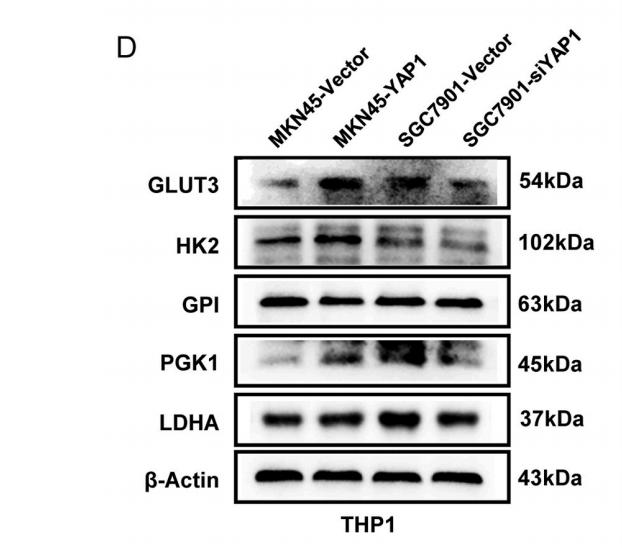PFKFB3 Antibody - #DF12016
| Product: | PFKFB3 Antibody |
| Catalog: | DF12016 |
| Description: | Rabbit polyclonal antibody to PFKFB3 |
| Application: | WB IHC |
| Cited expt.: | WB |
| Reactivity: | Human, Mouse, Rat |
| Mol.Wt.: | 58 kDa; 60kD(Calculated). |
| Uniprot: | Q16875 |
| RRID: | AB_2844821 |
Related Downloads
Protocols
Product Info
*The optimal dilutions should be determined by the end user. For optimal experimental results, antibody reuse is not recommended.
*Tips:
WB: For western blot detection of denatured protein samples. IHC: For immunohistochemical detection of paraffin sections (IHC-p) or frozen sections (IHC-f) of tissue samples. IF/ICC: For immunofluorescence detection of cell samples. ELISA(peptide): For ELISA detection of antigenic peptide.
Cite Format: Affinity Biosciences Cat# DF12016, RRID:AB_2844821.
Fold/Unfold
6 phosphofructo 2 kinase/ fructose 2,6 bisphosphatase; 6 phosphofructo 2 kinase/fructose 2,6 biphosphatase 3; 6-bisphosphatase; 6-P2ase 3; 6-P2ASE brain/placenta-type isozyme; 6PF 2 K/Fru 2,6 P2ASE brain/placenta type isozyme; 6PF 2-K/Fru 2,6 P2ase 3; 6PF-2-K/Fru-2; F263_HUMAN; fructose 6 phosphate,2 kinase/fructose 2, 6 bisphosphatase; Fructose-2; Inducible 6 phosphofructo 2 kinase/fructose 2,6 bisphosphatase; iPFK 2; iPFK-2; IPFK2; PFK/FBPase 3; PFK2; PFKFB3; Renal carcinoma antigen NY REN 56; Renal carcinoma antigen NY-REN-56; uPFK 2;
Immunogens
A synthesized peptide derived from human PFKFB3, corresponding to a region within C-terminal amino acids.
- Q16875 F263_HUMAN:
- Protein BLAST With
- NCBI/
- ExPASy/
- Uniprot
MPLELTQSRVQKIWVPVDHRPSLPRSCGPKLTNSPTVIVMVGLPARGKTYISKKLTRYLNWIGVPTKVFNVGEYRREAVKQYSSYNFFRPDNEEAMKVRKQCALAALRDVKSYLAKEGGQIAVFDATNTTRERRHMILHFAKENDFKAFFIESVCDDPTVVASNIMEVKISSPDYKDCNSAEAMDDFMKRISCYEASYQPLDPDKCDRDLSLIKVIDVGRRFLVNRVQDHIQSRIVYYLMNIHVQPRTIYLCRHGENEHNLQGRIGGDSGLSSRGKKFASALSKFVEEQNLKDLRVWTSQLKSTIQTAEALRLPYEQWKALNEIDAGVCEELTYEEIRDTYPEEYALREQDKYYYRYPTGESYQDLVQRLEPVIMELERQENVLVICHQAVLRCLLAYFLDKSAEEMPYLKCPLHTVLKLTPVAYGCRVESIYLNVESVCTHRERSEDAKKGPNPLMRRNSVTPLASPEPTKKPRINSFEEHVASTSAALPSCLPPEVPTQLPGQNMKGSRSSADSSRKH
Research Backgrounds
Synthesis and degradation of fructose 2,6-bisphosphate.
Phosphorylation by AMPK stimulates activity.
Ubiquitous.
In the C-terminal section; belongs to the phosphoglycerate mutase family.
Research Fields
· Environmental Information Processing > Signal transduction > HIF-1 signaling pathway. (View pathway)
· Environmental Information Processing > Signal transduction > AMPK signaling pathway. (View pathway)
· Metabolism > Carbohydrate metabolism > Fructose and mannose metabolism.
References
Application: WB Species: Human Sample: Gastric cancer (GC) cells
Restrictive clause
Affinity Biosciences tests all products strictly. Citations are provided as a resource for additional applications that have not been validated by Affinity Biosciences. Please choose the appropriate format for each application and consult Materials and Methods sections for additional details about the use of any product in these publications.
For Research Use Only.
Not for use in diagnostic or therapeutic procedures. Not for resale. Not for distribution without written consent. Affinity Biosciences will not be held responsible for patent infringement or other violations that may occur with the use of our products. Affinity Biosciences, Affinity Biosciences Logo and all other trademarks are the property of Affinity Biosciences LTD.


